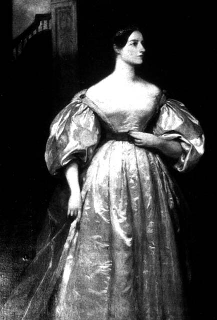

Ada Byron King was born in England on December 10, 1815. She was the daughter of Lord and Lady Byron who separated when she was still an infant. Lady Byron, a devoted mathematician, took full responsibility of raising Ada on her own. Being raised in the company of an extremely intelligent mother, Ada studied the science and methods of mathematics with the help of tutors. Ada learned astronomy, geometry, algebra and the likes during her very young ages of life.
When Ada was seventeen years old she met an extremely wise mathematician by the name of Mary Somerville. Mrs. Somerville became one of Ada's friends and teachers. She encouraged Ada to relate her knowledge of mathematics to the needs of humans. Through Ada's meetings with Mrs. Somerville, she was introduced to Charles Babbage, the genius behind the Analytical Engine. The ideas of Babbage's calculating engine inspired Ada and led her down a new path in life.
In 1843, Ada married the Earl of Lovelace, Lord William King. It was from this marrieage to the Earl that Ada got her title, Countess of Lovelace. All the while Ada became closely acquainted with Charles Babbage. She translated his speech given in Italy on this new device into English. When Ada showed Babbage the translation he insisted that she add her own notes to the article. From that point on Ada and Babbage communicated through letters back and forth about the new ideas and ways to make them work. Babbage nicknamed Ada "The Enchantress of Numbers".
Ada and Babbage became very famous for their works with the "Analytical Engine". Ada was the first to write a computer program for how the engine would calculate the Bernoulli numbers. She was such an important person in the history and development of computer programming that the United States Department of Defense developed a software language and named it "Ada".
In 1852, at the young age of 36, Ada died of illness. Life span during Ada's time was very short. But eventhough her life was short, her accomplishments were huge. She predicted that this engine would be capable of composing complex music and producing graphics, both of which our modern computing engines are capable of. It was the Countess of Lovelace's intelligence, imagination, and determination that allowed her to be known as the first computer programmer.
References Cited--
1. Toole, Betty Alexandra. "Ada Byron, Lady Lovelace." 1998. http://www.agnesscott.edu/lriddle.women/love.htm.
2. Toole, Betty Alexandra. Ada: The Enchantress of Numbers. Strawberry Press. 1992.
3. Weber, J.M. "Ada Byron Lovelace--The First Computer Programmer." http://www.aimsedu.org/Math_History/Samples/ADA/Ada.html.